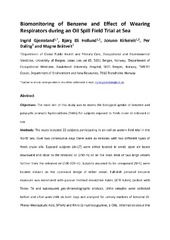Biomonitoring of Benzene and Effect of Wearing Respirators during an Oil Spill Field Trial at Sea
Peer reviewed, Journal article
Accepted version
Permanent lenke
https://hdl.handle.net/1956/19288Utgivelsesdato
2018-10Metadata
Vis full innførselSamlinger
Originalversjon
https://doi.org/10.1093/annweh/wxy067Sammendrag
Objectives The main aim of this study was to assess the biological uptake of benzene and polycyclic aromatic hydrocarbons (PAHs) for subjects exposed to fresh crude oil released at sea. Methods: The study included 22 subjects participating in an ‘oil-on-water’ field trial in the North Sea. Over 2 consecutive days, there were six releases with two different types of fresh crude oils. Exposed subjects (n = 17) were either located in small, open-air boats downwind and close to the released oil (<50 m) or on the main deck of two large vessels further from the released oil (100–200 m). Subjects assumed to be unexposed (n = 5) were located indoors on the command bridge of either vessel. Full-shift personal benzene exposure was monitored with passive thermal desorption tubes (ATD-tubes) packed with Tenax TA and subsequent gas chromatographic analysis. Urine samples were collected before and after work-shift on both days and analyzed for urinary markers of benzene [(S-phenylmercapturic acid (SPMA)] and PAHs [1-hydroxypyrene (1-OH)]. Information about the use of personal protective equipment, smoking habits, location, work tasks, and length of work-shift were recorded by a questionnaire. Results Subjects located in the small boats downwind and close to the released oil were exposed to relatively high concentrations of benzene (arithmetic mean = 0.2 ppm, range 0.002–1.5 ppm) compared to the occupational exposure limits (OELs) for 8 h (1 ppm) and 12 h (0.6 ppm). Although respirators were available to all exposed subjects, SPMA was detected in post-shift urine (0.5–3.3 µmol mol−1) of five exposed subjects reporting not wearing respirators, all located in the small boats downwind and close to the released oil. For exposed subjects wearing respirators (n = 12), the post-shift urinary SPMA was below the detection limit (0.8 µmol mol−1) even when the benzene exposure exceeded the OELs. Urinary levels of PAH were within the reference range of what is considered as background levels (<0.4 µmol mol−1). Conclusions During the initial stages of a bulk oil spill at sea, when the evaporation of benzene is at its highest, it is important to use appropriate respirators to prevent biological uptake of benzene.
